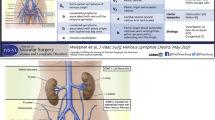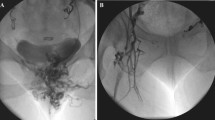Abstract
Objectives
To prospectively evaluate the safety and efficacy of embolization using ethylene vinyl alcohol copolymer (Onyx®) and Aetoxysclerol for treatment of pelvic venous disorders (PeVD).
Methods
This prospective study was approved by the institutional ethics review board. Ten clinical parameters were retained for evaluation of PeVD (pelvic pain, dyspareunia, post-coital pain, menstruation pain, lower limbs pain, difficulty walking, aesthetic discomfort, impact on daily working life, psychological impact and impact on daily life), measured on a visual analogue scale (VAS) between 0 and 10, and a global score out of 100 was noted before embolization, after 3 months during the imaging follow-up, and at the end of follow-up by phone call. The main criterion was clinical efficacy of embolization defined by an impairment score < 40/100 and a 50% decrease in overall score. Complications were recorded. Visualization of Onyx® on MRI 3 months after embolization was noted.
Results
Between July 2017 and May 2019, 73 consecutive women (mean age ± SD [range]: 41 ± 11 years [25–77]) treated by embolization with Onyx® and Aetoxysclerol were included. The median follow-up was 28 months [Q1–Q3: 24.0–29.2] (range: 18.1–34.5). The median initial VAS impairment score was 39/100 [29.75–48.50] (12–58). Clinical efficacy was obtained for 70 patients (70/73, 95.9%), and the median VAS impairment score at the end of follow-up was significantly lower at 3 [0.00–7.25] (0–73) (p < 0.0001). Four minor complications occurred. Onyx® was visualized on DIXON sequence of MRI for all patients.
Conclusion
Embolization using Onyx® and Aetoxysclerol for PeVD is safe and effective.
Key Points
• Embolization using Onyx ® and Aetoxysclerol for pelvic venous disorders is safe and effective.
• Imaging follow-up is facilitated by visualization of Onyx ® on MRI DIXON sequences.


Similar content being viewed by others
Abbreviations
- DMSO:
-
Dimethyl sulfoxide
- Onyx® :
-
Ethylene vinyl alcohol copolymer
- PACS:
-
Picture archiving and communication system
- PCS:
-
Pelvic congestion syndrome
- PeVD:
-
Pelvic venous disorders
- SIR:
-
Society of Interventional Radiology
- VAS:
-
Visual analogue scale
- VVLL:
-
Varicose veins in the lower limbs
References
Gültaşli NZ, Kurt A, Ipek A et al (2006) The relation between pelvic varicose veins, chronic pelvic pain and lower extremity venous insufficiency in women. Diagn Interv Radiol 12(1):34–38
Phillips D, Deipolyi AR, Hesketh RL, Midia M, Oklu R (2014) Pelvic congestion syndrome: etiology of pain, diagnosis, and clinical management. J Vasc Interv Radiol. https://doi.org/10.1016/j.jvir.2014.01.030
Greiner M, Gilling-Smith GL (2007) Leg varices originating from the pelvis: diagnosis and treatment. Vascular. https://doi.org/10.2310/6670.2006.00030
Bora A, Avcu S, Arslan H, Adali E, Bulut MD (2012) The relation between pelvic varicose veins and lower extremity venous insufficiency in women with chronic pelvic pain. JBR-BTR. https://doi.org/10.5334/jbr-btr.623
Khilnani NM, Meissner MH, Learman LA et al (2019) Research priorities in pelvic venous disorders in women: recommendations from a multidisciplinary research consensus panel. J Vasc Interv Radiol. https://doi.org/10.1016/j.jvir.2018.10.008 Epub 2019 Mar 8
Meissner MH, Khilnani NM, Labropoulos N et al (2021) The symptoms-varices-pathophysiology classification of pelvic venous disorders: a report of the American Vein & Lymphatic Society International Working Group on pelvic venous disorders. J Vasc Surg Venous Lymphat Disord. https://doi.org/10.1016/j.jvsv.2020.12.084
Hansrani V, Dhorat Z, McCollum CN (2017) Diagnosing of pelvic vein incompetence using minimally invasive ultrasound techniques. Vascular. https://doi.org/10.1177/1708538116670499
Lopez AJ (2015) Female pelvic vein embolization: indications, techniques, and outcomes. Cardiovasc Intervent Radiol. https://doi.org/10.1007/s00270-015-1074-7
Mahmoud O, Vikatmaa P, Aho P et al (2016) Efficacy of endovascular treatment for pelvic congestion syndrome. J Vasc Surg Venous Lymphat Disord. https://doi.org/10.1016/j.jvsv.2016.01.002
Meissner MH, Gibson K (2015) Clinical outcome after treatment of pelvic congestion syndrome: sense and nonsense. Phlebology. https://doi.org/10.1177/0268355514568067
Marcelin C, Izaaryene J, Castelli M et al (2017) Embolization of ovarian vein for pelvic congestion syndrome with ethylene vinyl alcohol copolymer (Onyx®). Diagn Interv Imaging. https://doi.org/10.1016/j.diii.2017.05.011
Black CM, Thorpe K, Venrbux A et al (2010) Research reporting standards for endovascular treatment of pelvic venous insufficiency. J Vasc Interv Radiol. https://doi.org/10.1016/j.jvir.2010.02.017
Greiner M, Faye N, Thouveny F (2013) Traitement endovasculaire par embolisation de l’insuffisance veineuse pelvienne chronique. Springer, Paris, p. 235–264. Available from: https://doi.org/10.1007/978-2-8178-0291-6_17
Maleux G, Stockx L, Wilms G, Marchal G (2000) Ovarian vein embolization for the treatment of pelvic congestion syndrome: long-term technical and clinical results. J Vasc Interv Radiol. https://doi.org/10.1016/s1051-0443(07)61801-6
Durham JD, Machan L (2013) Pelvic congestion syndrome. Semin Interv Radiol. https://doi.org/10.1055/s-0033-1359731
Gandini R, Chiocchi M, Konda D, Pampana E, Fabiano S, Simonetti G (2008) Transcatheter foam sclerotherapy of symptomatic female varicocele with sodium-tetradecyl-sulfate foam. Cardiovasc Intervent Radiol. https://doi.org/10.1007/s00270-007-9264-6
Laborda A, Medrano J, de Blas I, Urtiaga I, Carnevale FC, de Gregorio MA (2013) Endovascular treatment of pelvic congestion syndrome: visual analog scale (VAS) long-term follow-up clinical evaluation in 202 patients. Cardiovasc Intervent Radiol. https://doi.org/10.1007/s00270-013-0586-2
Guirola JA, Sánchez-Ballestin M, Sierre S, Lahuerta C, Mayoral V, De Gregorio MA (2018) A randomized trial of endovascular embolization treatment in pelvic congestion syndrome: fibered platinum coils versus vascular plugs with 1-year clinical outcomes. J Vasc Interv Radiol. https://doi.org/10.1016/j.jvir.2017.09.011
Smith PC (2012) The outcome of treatment for pelvic congestion syndrome. Phlebology. https://doi.org/10.1258/phleb.2011.012s01
Venbrux AC, Chang AH, Kim HS et al (2002) Pelvic congestion syndrome (pelvic venous incompetence): impact of ovarian and internal iliac vein embolotherapy on menstrual cycle and chronic pelvic pain. J Vasc Interv Radiol. https://doi.org/10.1016/s1051-0443(07)61935-6
Pieri S, Agresti P, Morucci M, de Medici L (2003) Percutaneous treatment of pelvic congestion syndrome. Radiol Med 105(1–2):76–82
Kim HS, Malhotra AD, Rowe PC, Lee JM, Venbrux AC (2006) Embolotherapy for pelvic congestion syndrome: long-term results. J Vasc Interv Radiol. https://doi.org/10.1097/01.RVI.0000194870.11980.F8
Hocquelet A, Le Bras Y, Balian E et al (2014) Evaluation of the efficacy of endovascular treatment of pelvic congestion syndrome. Diagn Interv Imaging. https://doi.org/10.1016/j.diii.2013.09.011
Saeed Kilani M, Izaaryene J, Cohen F et al (2015) Ethylene vinyl alcohol copolymer (Onyx®) in peripheral interventional radiology: indications, advantages and limitations. Diagn Interv Imaging. https://doi.org/10.1016/j.diii.2014.11.030
Jambon E, Le Bras Y, Petitpierre F et al (2020) MRI associated factors of clinical efficacy of embolization in patients with pelvic venous insufficiency. Diagn Interv Imaging. https://doi.org/10.1016/j.diii.2020.06.004
Dindo D, Demartines N, Clavien PA (2004) Classification of surgical complications: a new proposal with evaluation in a cohort of 6336 patients and results of a survey. Ann Surg. https://doi.org/10.1097/01.sla.0000133083.54934.ae
Leoni CJ, Potter JE, Rosen MP, Brophy DP, Lang EV (2001) Classifying complications of interventional procedures: a survey of practicing radiologists. J Vasc Interv Radiol. https://doi.org/10.1016/s1051-0443(07)61403-1
Gloviczki P, Comerota AJ, Dalsing MC et al (2011) The care of patients with varicose veins and associated chronic venous diseases: clinical practice guidelines of the Society for Vascular Surgery and the American Venous Forum. J Vasc Surg. https://doi.org/10.1016/j.jvs.2011.01.079 PMID: 21536172
Monedero JL, Ezpeleta SZ, Perrin M (2012) Pelvic congestion syndrome can be treated operatively with good long-term results. Phlebology. https://doi.org/10.1258/phleb.2011.012s03
Paisant-Thouveny F, Le Pennec V, Loffroy R (2019) Varicoceles, pelvic varices and pelvic congestion syndrome: interventional radiology in diagnosis and treatment. Presse Med. https://doi.org/10.1016/j.lpm.2019.03.008
Vollherbst DF, Otto R, Do T et al (2018) Imaging artifacts of Onyx and PHIL on conventional CT, cone-beam CT and MRI in an animal model. Interv Neuroradiol. https://doi.org/10.1177/1591019918782692
Saatci I, Cekirge HS, Ciceri EFM, Mawad ME, Pamuk AG, Besim A (2003) CT and MR imaging findings and their implications in the follow-up of patients with intracranial aneurysms treated with endosaccular occlusion with Onyx. AJNR Am J Neuroradiol 24(4):567–78
De Gregorio MA, Guirola JA, Alvarez-Arranz E, Sánchez-Ballestin M, Urbano J, Sierre S (2020) Pelvic venous disorders in women due to pelvic varices: treatment by embolization: experience in 520 patients. J Vasc Interv Radiol. https://doi.org/10.1016/j.jvir.2020.06.017
van der Vleuten CJM, van Kempen JAL, Schultze-Kool LJ (2012) Embolization to treat pelvic congestion syndrome and vulval varicose veins. Int J Gynaecol Obstet. https://doi.org/10.1016/j.ijgo.2012.04.021
Labropoulos N, Delis K, Nicolaides AN, Leon M, Ramaswami G (1996) The role of the distribution and anatomic extent of reflux in the development of signs and symptoms in chronic venous insufficiency. J Vasc Surg. https://doi.org/10.1016/s0741-5214(96)80018-8
Murugesan C, Saravanan S, Rajkumar J, Prasad J, Banakal S, Muralidhar K (2008) Severe pulmonary oedema following therapeutic embolization with Onyx for cerebral arteriovenous malformation. Neuroradiology. https://doi.org/10.1007/s00234-007-0348-4
Asouhidou I, Katsaridis V, Meng L et al (2010) Desaturation during Onyx embolization. Br J Anaesth. https://doi.org/10.1093/bja/aeq222
Acknowledgements
Pippa McKelvie-Sebileau for medical editorial assistance in English.
Funding
The authors state that this work has not received any funding.
Author information
Authors and Affiliations
Corresponding author
Ethics declarations
Guarantor
The scientific guarantor of this publication is Clément Marcelin.
Conflict of interest
The authors of this manuscript declare no relationships with any companies whose products or services may be related to the subject matter of the article.
Statistics and biometry
One of the authors has significant statistical expertise.
Informed consent
Written informed consent was obtained from all subjects (patients) in this study.
Ethical approval
Institutional review board approval was obtained.
Study subjects or cohorts overlap
Some study subjects or cohorts have been previously reported last year in Diagnostic and Interventional Imaging.
Methodology
• prospective
• experimental
• performed at one institution
Additional information
Publisher’s note
Springer Nature remains neutral with regard to jurisdictional claims in published maps and institutional affiliations.
Rights and permissions
About this article
Cite this article
Jambon, E., Le Bras, Y., Coussy, A. et al. Embolization in pelvic venous disorders using ethylene vinyl alcohol copolymer (Onyx®) and Aetoxysclerol: a prospective evaluation of safety and long-term efficacy. Eur Radiol 32, 4679–4686 (2022). https://doi.org/10.1007/s00330-022-08567-z
Received:
Revised:
Accepted:
Published:
Issue Date:
DOI: https://doi.org/10.1007/s00330-022-08567-z




